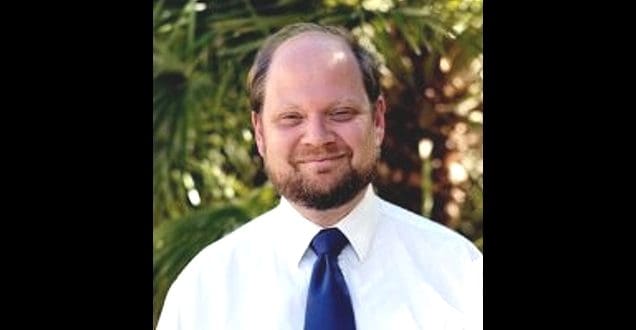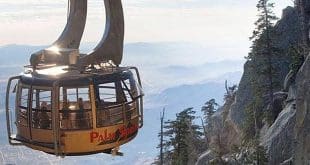John Raymond serves as the Director of Community & Economic Development for the City of Palm Springs. He has a Master’s Degree in Public Policy and Management from Carnegie Mellon University. Originally from Holyoke, Massachusetts, John lives with his wife Laura and two sons in Palm Springs. Kate Buckley recently sat down with John to learn more about his background and what’s next for Palm Springs.
John, you’re originally from Massachusetts but have lived in Southern California since 1990—first Upland, then Palm Springs. What brought you here?
JR: When I graduated from Carnegie Mellon, I fell into a job as a Main Street Project Manager in my hometown. But my wife only moved to the East Coast from California to go to grad school, fully intending to go back. After meeting me it meant another year in Pittsburgh and three years in Massachusetts. By 1990, “we” decided we’d had enough of the East Coast. So I started looking in California.
Your first position in California was as Executive Director for Main Street Upland. What was your most significant project there?
JR: Upland created a Main Street program for two reasons: their downtown anchor, a small local department store, had just burned down, and they were facing a new state law requiring the seismic retrofit (earthquake-proofing) of unreinforced masonry buildings. They had a lot of older brick buildings, and the average retrofit cost was something like $40,000 per building—a big hit to property owners. But I helped develop a strategy and managed to retrofit about 26 of the 54 buildings in two years, almost entirely paid by the private owners. The Grove Theatre was pure serendipity. It was a vacant movie theatre owned by a guy who wanted to turn it into an indoor swap meet—terrible for any downtown. The City pushed back, and we were lucky to get a call from Sherry Kinison [Sam Kinison’s sister-in-law], who wanted to convert it to live theatre. They removed seats and built a stage, backstage, and technical booth. We even got assistance from Sinclair Paints on the appropriate paint colors for the historic 1947 marquee. She’s still there doing a great job 22 years later. Amazing!
In 1998 you were named Director of Community & Economic Development for the City of Palm Springs and served in that capacity for 10 years. In December 2008 you moved to Fresno to serve as Assistant Executive Director for the Fresno Redevelopment Agency, what prompted that shift?
JR: By 2008, I had been with the City for nearly 15 years and I wasn’t ready to spend my entire career in one place. I saw the Fresno job, and they had a number of projects that seemed interesting—like the agreement with Forest City, one of the largest urban residential developers in the country, for a $300 million redevelopment project in the downtown. Fresno also has 41,000 employees that work in the downtown but there’s maybe a half dozen places in downtown to grab dinner after 6 p.m. They also have tremendous blight in their urban neighborhoods. The challenges were pretty compelling.
Fresno has more concentrated urban poverty than any major city in the United States, yet you’ve referred to your time there as your “sabbatical.” Why?
JR: I was only there 20 months, but in that time I did 10 affordable housing deals. Plus, we got Federal money to purchase and rehab foreclosed homes. I spent part of every day for nearly a year house shopping. How fun is that? We worked in several historic neighborhoods, and we bought houses that were the worst on the street and improved them enough to make them the best houses on the street. It made an extraordinary difference, but it also meant we over-invested in the property from a strictly economic perspective. But the program did exactly what it was intended to do: stabilize neighborhoods. I also did an odd deal: the sale of the land under the Radisson Hotel to the hotel owner. It was one area where my experience here was key—Palm Springs has lots of leased land. The sale proceeds retired part of the Convention Center debt and saved the City $1,000,000 per year.
John, you clearly have considerable experience dealing with affordable housing; do you think there’s a need for additional low-income housing in Palm Springs?
JR: Most cities in California are chronically short of affordable housing. It’s only going to get worse as the State has eliminated redevelopment agencies. We recently wrote a check to the State for all—yes, all—of our housing money. Several years ago, we were told we needed more large-family rental housing and since then, about 125 units have been built. But we can use more quality senior apartments. There are special needs populations that need housing—persons at risk of homelessness, with HIV/AIDS, even with mental health issues. And the Valley has only begun to confront housing for working people that are not “poor,” but unable to afford the median priced house.
In September 2010, you had the opportunity to move back to Palm Springs and resume your position of Director of Community & Economic Development. And you walked right into the negotiations with Wessman Development over the Desert Fashion Plaza. Can you give us a little background on this?
JR: By the time I came back in 2010, I had a little different perspective than in 2008, in part from Fresno’s experience with Forest City. That $300 million project had a “gap”—the difference between the cost to build and its real value—of over $75 million, and maybe $100 million. Nobody ever faced it, nobody figured out how to close the gap, even after the parties spent $4 million on an EIR. The economy then forced the issue and Forest City walked. The relationship between the City and Wessman had gotten off track in 2010. Wessman argued that the recession was the wrong time to put a deal together. The City was frustrated with year after year of delay. Once they approved the Specific Plan in late 2009, they believed it was the last hurdle and that Wessman needed to perform. But I’d also worked on the previous two developers’ proposals, and the project always had a financing gap, even then. Wessman was always going to need assistance, but that wasn’t the conversation we were having.
Along with Mayor Steve Pougnet and the Palm Springs City Council, you then brokered the Desert Fashion Plaza Financing Agreement—an agreement with Wessman Development to redevelop 13 acres in the middle of downtown Palm Springs. It included the City’s purchase of parking and a commitment to construct new streets through the site, and the developer’s commitment to build the project. Why do you feel this project is so important to Palm Springs?
JR: I can’t take any credit for brokering the deal—that was the Council authorizing Mayor Pougnet and Council Member Mills to have one final meeting with Wessman to see if they could craft a deal. I wasn’t even there. That was even after we had the “eminent domain” meeting with Wessman and the attorneys. They all deserve credit for taking a step back and coming up with a plan to cooperate, that was forward looking. My job is to be aware of all the pieces of the project: the Project Financing Agreement, the bond issue, the escrow, the design and entitlement process, the event center, the parking garages, demographic research, etc.
It’s important to give the Council the credit because this is important—it may be the most important project the City undertakes for the next several decades—and they’re the only ones that could have done it. It’s our “100% corner”—the most dynamic economic location in the City, and as long as nothing moved forward there it didn’t matter what else happened in the City, because the perception was that “Palm Springs is dead, there’s nothing downtown, it’s full of vacancies, etc.” The emotion spent in negotiating with Wessman on the mall was entirely a function of how our own success is tied to the location’s success.
I know cost has been a major concern around this project. For instance, it costs as much to build this project in downtown Palm Springs (minus the land) as it would in Beverly Hills, but the rents will be considerably lower. How have you navigated this issue?
JR: Rents are going to be strong for the project, but they won’t be Beverly Hills rents. And, there are four parts of the cost in a project like this: the land, the materials (concrete, steel, wood), labor, and soft costs (financing, architecture, marketing). The land is most variable but reflects the economic potential of the location itself. Material costs are pretty consistent from area to area. There’s some variability in construction labor costs, but the more skilled the trade—like heavy equipment operators—the more the wages are “regional.” Financing costs aren’t likely to be less in Palm Springs than in LA. Designers and consultants typically charge the same no matter the market. That’s why developers—and cities—have to be extraordinarily creative to get things to happen. And that’s why the City Council has created a myriad of incentive programs to move projects in this city forward.
John, you’ve said that you think theaters are very important and create such energy in communities—from the Grove Theater in Upland to the Annenberg Theater in Palm Springs. Can you comment on what might be next for the City-owned Plaza Theater now that the Fabulous Palm Springs Follies has announced their final season?
JR: When I started working in Downtown Holyoke the most important project was the renovation of the 1919 Victory Theater, the last surviving movie palace in the downtown. At that time, in 1987, it had been closed for a decade. The project is finally underway, 25 years later. So for 35 years, the restoration of the Victory has been a key objective there—it was that important. In Upland, The Grove was really an afterthought for most residents, but the theatre did such a great job staging productions, building a subscriber base, and bringing in the occasional celebrity—that it’s still the most exciting thing in an otherwise sleepy downtown.
Even here in Palm Springs, we’ve charted the progress of the area at Palm Canyon and Alejo since 1997, when Palm Canyon Theatre first opened. People have forgotten how run-down that area was then, compared to today. In terms of the Follies, this is their last season. I know they’ll put on a great show, and their fans will show up to support them and to say farewell. They’ll go out on a real high note. As far as what happens after the Follies, there’s a lot of interest in the theatre from all sorts of groups. In the end, the City Council will decide which direction they want to go, and we’re grateful that we have plenty of time to consider the options.
How have you seen the City change since you first moved here in the mid-90s? What changes would you still like to see occur?
JR: When I started here in 1993, we reprinted a USA Today article about Palm Springs—one of the first that talked about how Palm Springs was “coming back.” It quoted Sonny Bono, who said “The great thing about Palm Springs is that there’s nothing to do.” After 19 years I finally get it. We run into people all the time that come back year after to do “absolutely nothing.” They drink their coffee and look at the mountains. They take a dip in the pool. They read. They walk downtown and have lunch. It’s not really “nothing,” of course, but they’re also not running to catch the tram to Disneyland. And that was Bono’s point.
The fact is, there is plenty to do today, and that’s why people come here – more every year. When I started there was no Coachella; the City was still running a “Wildflower Festival” downtown as a replacement for Spring Break; the Film Festival was not the A-list destination it is today; there was no Tour de Palm Springs or Modernism Week; the Bob Hope Classic was losing steam; what is today the BNP Paribas was played at the Hyatt Grand Champions. And the White Party and the Dinah Shore Weekend were here but are so much more mainstream today than ever. The mix of groups that love Palm Springs is amazing.
What do you think are the most critical issues—or opportunities—facing Palm Springs?
JR: The issue that’s as important today as in 1993 is developing good jobs. Back then we worked to recruit and retain manufacturers here and we still do. But it’s up and down: we had a couple of great local companies that, within a few years of each other, were acquired by the same Fortune 500 company and moved out of state. We’re fortunate to have some larger employers here, because they add a dimension to the local economy besides the jobs, but cities all over the world also value “grow your own” economic development. That’s why we’ve been so committed to the Coachella Valley Innovation Hub (iHub) operated by the Coachella Valley Economic Partnership. This incubator is designed to help local entrepreneurs get through the early, treacherous stages of the business life cycle.
What is the future you’d most like to see for Palm Springs?
JR: A great, vibrant downtown, a dynamic creative economy, and a culture of entrepreneurship that yields and lots more jobs in all sorts of industries. A mix of housing, and a chance for kids to go to college and then come back and not be underemployed. Oh, and more live music.
John Raymond, why do you feel so passionately about the community of Palm Springs?
JR: Because we’re like no place else. And I really mean that.







Inspiring and comprehensive vision for the city. Thank you!
Cool site, thanks for posting this, I am at the moment studying to be a professional event planner, I will book mark this blog site, many thanks for your efforts in publishing the blog.